9.4 /10 1 Votes9.4
87% Metacritic | 10/10 Steam Initial release date 9 October 2006 | |||||||||||||||||||||||||||||||||
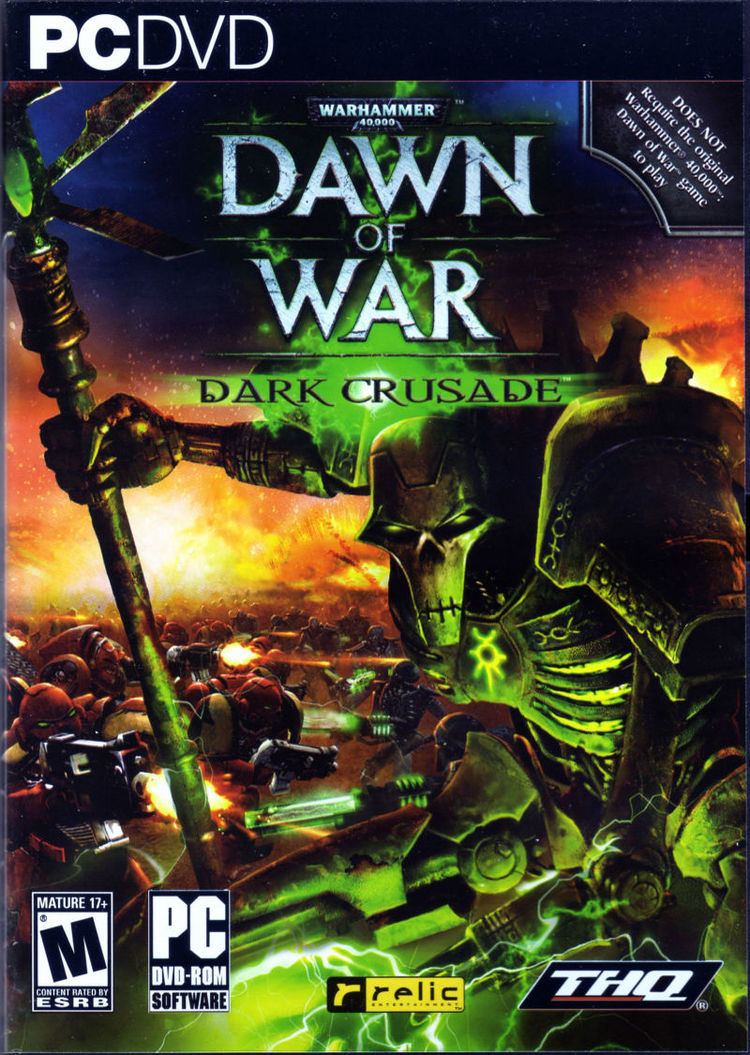 | ||||||||||||||||||||||||||||||||||
Engine Impossible Creatures (modified version) Similar Warhammer 40 - 000: Dawn of, Warhammer 40 - 000: Dawn of, Warhammer 40 - 000: Dawn of, Warhammer 40 - 000: Dawn of, Warhammer 40 - 000: Dawn of | ||||||||||||||||||||||||||||||||||
Warhammer 40,000: Dawn of War – Dark Crusade is the second expansion to the PC-based RTS game Warhammer 40,000: Dawn of War developed by Relic Entertainment and published by THQ. Based on Games Workshop's popular tabletop wargame, Warhammer 40,000, Dark Crusade was released on October 9, 2006. The expansion features two new races, the Tau Empire and the Necrons. Including the Imperial Guard from Dawn of War's first expansion pack Winter Assault, this means a total of seven playable races in this expansion.
Contents
- Gameplay
- Units
- Multiplayer
- Campaign
- Races
- Tau Empire
- Necrons
- Notable characters
- Canonical Ending
- Development
- Reception
- Mods
- References
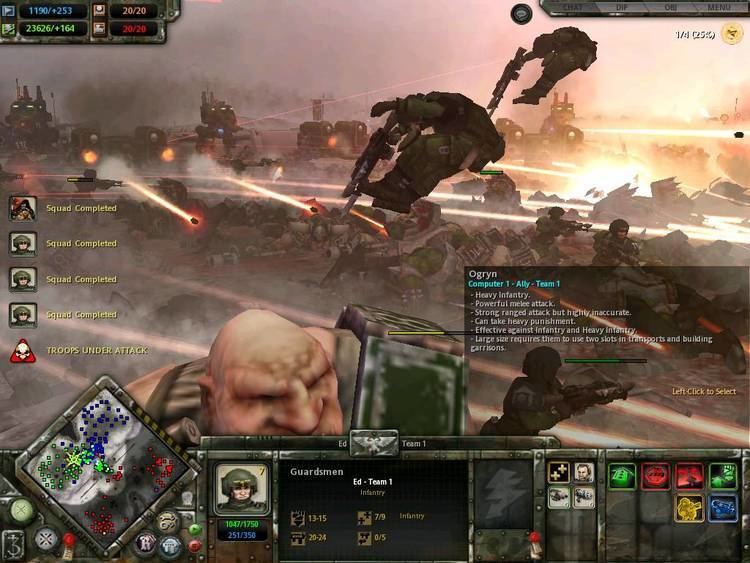
Unlike Winter Assault, Dark Crusade is a standalone expansion that does not require prior installation of Dawn of War or Winter Assault to play, allowing the user to play as all seven factions in both single player Skirmish and Campaign modes.

Parallel to the release of Dark Crusade, THQ also released a triple pack of Dawn of War, Winter Assault, and Dark Crusade, dubbed Dawn of War Anthology. The case is embossed with images of all the faction leaders of the campaign dressed in their respective wargear.

Gameplay
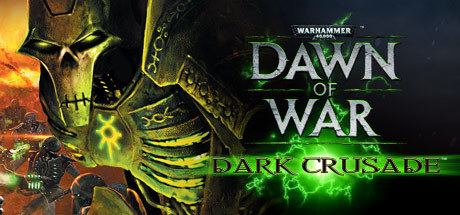
As with previous Dawn of War titles, Dark Crusade is focused on the conflict part of gameplay; in order to obtain more resources players must fight over them. Each player starts off with a base and wins by fulfilling mission objectives. There are multiple tiers of technology, with each allowing for more powerful units and upgrades.
Units
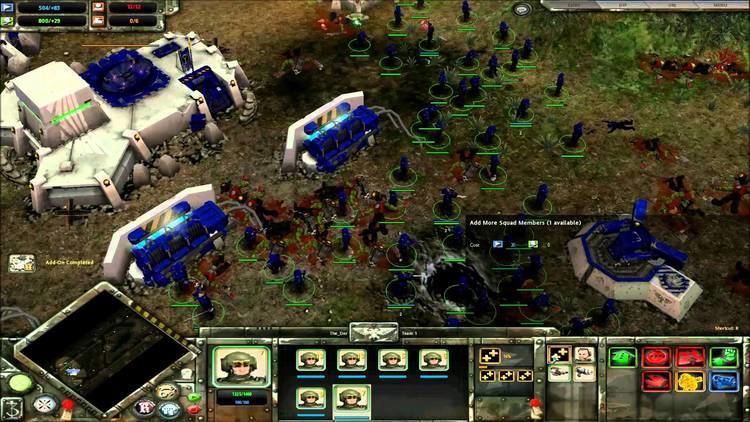
The number of units a player may field at one time is determined by population and vehicle 'squad caps'; these limit the number of infantry troops and vehicles a player may have on the battlefield. Squad caps may be increased using methods differing between races. Most units have a melee attack and a ranged attack. Units are often specialized to be better using one attack type. All units also have stances; these affect how the units respond to enemies. There are six types of units: commanders, infantry, heavy infantry, daemons, vehicles, and Titans.
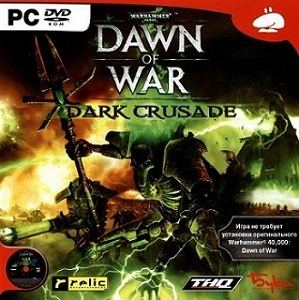
Commanders are hero units, and can usually only be built once. If they perish, they may be rebuilt. A sub-class is the semi-commander unit, which has many abilities like the commander unit but may be built multiple times. Infantry are foot soldiers, and may either be regular or heavy, with heavy infantry being much tougher than normal infantry. Vehicles are heavy weaponry and transports, and include tanks, artillery, troop carriers and walkers. Titans are end-game units, which usually require the highest tech level and a captured relic. Titans appear as all the other unit types depending on Factions. like Commanders they can only be built once and may be rebuilt.
All units, aside from titans and most heroes, builders and vehicles, come in squads. These are groups of infantry that are commanded as a single entity. They may be reinforced with additional members, equipped with special weapons, or be attached to hero units. Some squads have special abilities, such as grenades, teleportation, and stealth, unlocked with research or leader units. Unit longevity is determined by their health and morale points, which govern a squad's fighting effectiveness. Both are reduced by weaponry; morale recharges independently or due to unit abilities, while health is increased by healer units or repair, with some units also able to heal themselves. The Necrons have the ability to reassemble themselves and spawn again.
Multiplayer
Players may either connect directly by IP connection, or play on their LAN. There are eight game modes available for online skirmish play, such as Annihilate, which requires the player to destroy every enemy buildings capable of unit production or Sudden Death, which causes a player to be eliminated if another captures one of their strategic points. Multiple game modes may be enabled, calling for multiple winning conditions. Due to its nature as a standalone expansion pack, the player may only play as the Tau or Necrons in multiplayer. They may enter their original Dawn of War CD key to gain access to the original four races. Likewise, a Winter Assault CD key is needed to access the Imperial Guard.
Campaign
The expansion features a "Risk-based strategic layer", a campaign including a "meta-map", similar to that in Westwood Studios's Dune games as opposed to the programmed, linear storylines of previous versions. Due to this lack of linearity, there is no plot aside from the opening cinematic; rather, as the player conquers various opposing factions the game provides a narrative specific to whom the player has conquered. If the player wins the campaign, a cinematic is played that depends on which faction the player was controlling.
The player may pick a faction to play as, and then engages in turn-based combat with the other A.I.-controlled factions. There are multiple provinces, which are conquered by fighting a regular skirmish match over them. These may either give a special bonus or supply special 'honour guard' units, which are powerful, non-trainable versions of regular units. They may only be made on the main battlefield overview screen, and, like provincial reinforcements, cost planetary requisition, a resource gained on a per-turn basis based on how many provinces the player controls. Honour guard units transfer over provinces and may be used repeatedly. There are also seven 'Stronghold' provinces that function as bases for respective factions; these are made like more traditional campaign games, with multiple secondary and primary objectives that vary from faction to faction.
Also, a race's commander unit may be upgraded with special "wargear", unique, customizable upgrades that vary by race. These are awarded at battle milestones, ranging from a certain amount of kills to conquering many provinces.
Campaign scenarios are persistent, meaning that all player structures are 'saved' when a game is won. For example, if a player builds a base and conquers a province, only to have a neighbouring faction attack aforementioned province, the player will start out with his previous base, with the exception of having no technology researched. Also, the CPU always starts out in the same spot, rather than being random. If you build a defense around the CPU's starting point and it's too close, it will be removed at the beginning of the defense match. Players may also choose to garrison provinces with units that are instantly available should the province be attacked. These are bought with planetary requisition.
Races
All five of the pre-existing factions gain new units, and two new playable races are available.
Tau Empire
One of the two newer races, the Tau are unique in multiple ways. Tau warriors and vehicles are powerful in ranged battles, but lack melee prowess; their commander even lacks a melee attack entirely. Many Tau units tend to be relatively fragile, few in number, and expensive. To compensate, they fight alongside the alien Kroot, using these primal warriors as auxiliaries. Also, they are the only race with a 'choice' in their final technology choices; two final tier buildings are presented, which provide different end-game units and technologies. Only one may be chosen. The Tau also do not have any standalone defensive structures or minefields. However one of their Heavy Infantry; the Broadside Battlesuit, can be entrenched and use its shoulder mounted railguns, effectively making them into turrets.
Necrons
The Necrons are unique, as they do not require requisition to build their army. All units are in and of themselves free of requisition point cost. Power is the only resource Necrons need, in order to perform research, construct buildings and to construct and reinforce squads. However, capturing Strategic Points and building Obelisks (the Necrons listening post) on them will increase the speed of research and building, and will also expand the population cap. The Necron Monolith, their home base, is restored as more buildings are built, while also unlocking new units (similar to the Zerg in StarCraft), and functions as the only vehicle- and troop-producing building. When fully restored it becomes mobile (albeit very slow, though it can teleport) and is armed with powerful weaponry. Many Necron units have the ability to resurrect, and most will leave persistent corpses on the battlefield that may either self-resurrect after they die or be restored by specialized Necron units (this resurrection can actually allow the Necrons to go over their population cap).
Necrons were previously seen in Winter Assault at the end of the single-player campaign, but noticeably stronger.
Notable characters
Dark Crusade features some reappearances by characters in past games, such as Farseer Taldeer and Warboss Gorgutz 'Ead 'Unter, who were featured in Winter Assault and Shas'la Tau Kais who featured in the first person shooter game Fire Warrior now as Shas'O Tau Kais the Commander of the Tau involved in the Dark Crusade.
Campaign
The events of Dark Crusade take place on the planet of Kronus, a world on the eastern fringe of the Imperium, where the local human population un-easily co-exists with the nearby Tau Empire. An ancient Titan Hellstorm Cannon firmly entrenched in Victory Bay and the need to aid the local human population are the very reasons the Imperial Guard arrive on Kronus to "liberate" them from Tau rule. It is also an ancient Necron tomb world, whose inhabitants are starting to awaken. Eldar from Craftworld Ulthwé soon arrive to stop the Necron threat from growing. In addition, Kronus happens to be a world with hidden relics, left behind from the Horus Heresy, that are significant to the Blood Ravens and the Word Bearers Legion. There is also a local Ork population in the southern jungles who quickly mobilizes against the new threats after becoming united under a new warboss. Faced with such opposition against the thriving colony, The Tau Ethereal Aun'el, knowing the world must be kept, orders the Fire Warriors into battle against the other factions.
Canonical Ending
The fate of the Kronus System depends on the actions taken by the various factions fighting over it, but the only known details on the canonical ending come from dialogue in the sequel, Warhammer 40,000: Dawn of War II that the Blood Ravens won the Dark Crusade. Captain Davian Thule lost his left eye after his battle with the Necron Lord of Kronus.
Development
Dark Crusade uses the same engine as the original Dawn of War game, which allowed game developer Relic to focus most efforts on revamping the single-player campaign and balancing out the two new races. By E3 2006, the two new races were demonstrated through an in-engine feature, though no playable version was showcased. New units were unveiled regularly after August 11. The first available playable build was released on September 18 to GameSpot. Dark Crusade exited the development stage on September 21, and was expected to be shipped worldwide by October 9.
Reception
The expansion was praised as an "excellent real-time strategy game", with its non-linear single-player campaign, stabilized multiplayer and additional features, and was selected by IGN and GameSpot as the best expansion pack of 2006. Most were quite surprised by the quality and size of the expansion, stating that the large amount of new content "[breathed] new life into the game". Critics cited the excellent balancing between races, saying it had a positive effect on both single-player and multiplayer. Aside from new units and races, changes to the gameplay mechanics, such as reworking of the elite unit system, were well-received, as critics felt that the changes "forced players to actually think about using real combined arms tactics in multiplayer and contributed to more games decided by genuine strategy and skill rather than just who can spec out the proper build order."
Some critics stated that the game's weak points included its complexity; some reviewers disliked how much micromanagement was required to effectively field one race against another, saying that this complexity was detrimental to the game. As one reviewer mentioned, "...when I stop having fun, I stop playing." The learning curve was also stated as being very steep for an RTS, due to each race being different. Another thing critics disliked was the player's inability to 'zoom out' with the in-game camera; this sometimes got in the way of large battles, and was especially noticeable when playing as or against the Tau, as their long-range weapons often resulted in them engaging their targets off-screen. While general consensus on the revamped single-player campaign was positive, some critics felt that it was not particularly challenging; they found that the AI was strategically weak, and there were no random elements in most skirmish missions that would enhance replayability. The usage of a random auto-resolve feature to determine which races won which territories was seen as a downside; also, one critic found that the AI attacked his homebase very rarely, and that they would attack insignificant zones regardless of the opportunity to capture more significant ones. In terms of new additions, some critics felt that the races, in particular the Necrons, were overpowered.
Mods
There are a number of user-created mods that have been created to enhance the game. In many cases, these mods add new units and bring the gameplay closer to that of the table top game.
